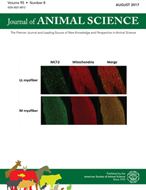-
Views
-
Cite
Cite
D. Solà-Oriol, E. Roura, D. Torrallardona, Feed preference in pigs: Effect of cereal sources at different inclusion rates, Journal of Animal Science, Volume 87, Issue 2, February 2009, Pages 562–570, https://doi.org/10.2527/jas.2008-0949
Close - Share Icon Share
ABSTRACT
The palatability of different cereals was studied in 2 two-way choice (preference) experiments using pigs of 56 d of age and 17 kg of BW. In Exp. 1, the effect of 24 cereals vs. a common reference diet containing white rice on feed preference in pigs was studied. Pigs were offered free choice between the reference diet and a diet with the cereal under study for 4 d. Barley, corn (2 sources), wheat, cassava meal, biscuit meal, rye, sorghum, and 1 source of oats were tested at inclusion rates of 300 and 600 g·kg−1. Short-grain rice (whole, brown, or extruded white), long-grain white rice (raw and cooked), extruded barley, extruded corn, extruded wheat, oats (2 sources), thick rolled oats, cooked oats, and naked oats (raw, extruded, or micronized) were tested at inclusion rates of 150, 300, and 600 g·kg−1. Relative preference of cereals (% of total feed intake) was affected by type of cereal and by rate of inclusion. The diets containing extruded rice (150 g·kg−1), extruded naked oats (150, 300, and 600 g·kg−1), or naked oats (150 and 300 g·kg−1) were preferred (P < 0.05) by pigs to the reference diet. However, the reference diet was preferred (P < 0.05) to the diets containing 150, 300, and 600 g·kg−1 of cooked long-grain rice, oats, or cooked oats, 300 and 600 g·kg−1 of extruded wheat, wheat, corn, sorghum, or unhulled short-grain rice, and 600 g·kg−1 of thick rolled oats, extruded corn, rye, extruded barley, micronized naked oats, barley, cassava, or biscuit meal. Extrusion improved (P < 0.05) preference values for corn and naked oats by pigs, but had no effect on barley, rice, or wheat. In Exp. 2, the preferences of pigs for oats and barley were studied using mash and pelleted diets. Diet form did not affect preference in oats diets. However, for barley, greater preference values were obtained when measured in pelleted form compared with mash form. Additionally, direct 2-way choices were also performed between oats and barley diets and between diets presented in mash and pelleted forms. Pigs preferred barley to oats, and preferred diets presented in pelleted form to those presented in mash form. In conclusion, cereal type, inclusion rate, and diet form affected feed preference in pigs. Using cereals with greater preference values may contribute to the formulation of more palatable feeds, which enhance feed intake of piglets at critical stages such as weaning time.





